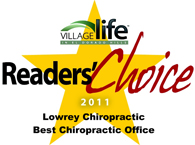Sciatica: Difficult to Diagnose, Simple to Treat
Friday, December 2nd, 2011 Pain can come in many forms but one of the worst forms of discomfort can originate from disruption of the sciatic nerve. The relentless pain that is felt along the sciatic nerve is medically described as “sciatica”. This nerve, which is the widest and longest in the body, runs from the lower back, through the buttocks and down the back of each leg. The function of the nerve is to provide sensation to the thighs, legs, and feet, and it also controls the calf muscles.
Pain can come in many forms but one of the worst forms of discomfort can originate from disruption of the sciatic nerve. The relentless pain that is felt along the sciatic nerve is medically described as “sciatica”. This nerve, which is the widest and longest in the body, runs from the lower back, through the buttocks and down the back of each leg. The function of the nerve is to provide sensation to the thighs, legs, and feet, and it also controls the calf muscles.
Sciatica is a description of symptoms as opposed to a diagnosis of what may be irritating the sciatic nerve which in turn gives rise to the pain. It is a rather common form of lower back and leg discomfort but what is often misunderstood is that the condition tends to result from general wear and tear on lower spine structures. Some medical professionals falsely interpret this wear and tear as injury-related, when, in fact, it’s a nerve issue.
The most common symptom is a pain that spreads out along the path of the sciatic nerve, beginning with the lower back and extending down one leg. However, there are many other symptoms too, and these can vary widely depending on the exact point at which the sciatic nerve becomes affected. Some sufferers may experience a mild tingling sensation or achiness, while others may feel sharp pain one side of their body. The frequently described pins-and-needles sensation is a common symptom, too, and is usually felt in the foot or toes. Sciatica pain typically begins slowly then gradually becomes unbearable with sudden involuntary actions such as sneezing or coughing bringing on severe pain.
Most sciatica sufferers often respond well to sciatica chiropractic treatment in its various forms. But, it’s important to note that sciatica is a symptom and not a medical condition. Sciatica treatment plans will vary according to the underlying causes of the pain. The American Chiropractic Association (AMA) recommends a non-invasive, drug-free treatment option to ease the pain of sciatica. . Once there is a full examination, there will be a recommendation of an effective sciatica treatment program that should quickly have you functioning normally again. Treatments may include a combination of electric muscle stimulation, specialized stretching, low back adjustments, and muscle therapies including myofascial release and trigger point therapy to quickly reduce and eliminate pain and get you back on your feet.
To learn more about treatment of sciatica or to schedule an evaluation, please contact us today!






